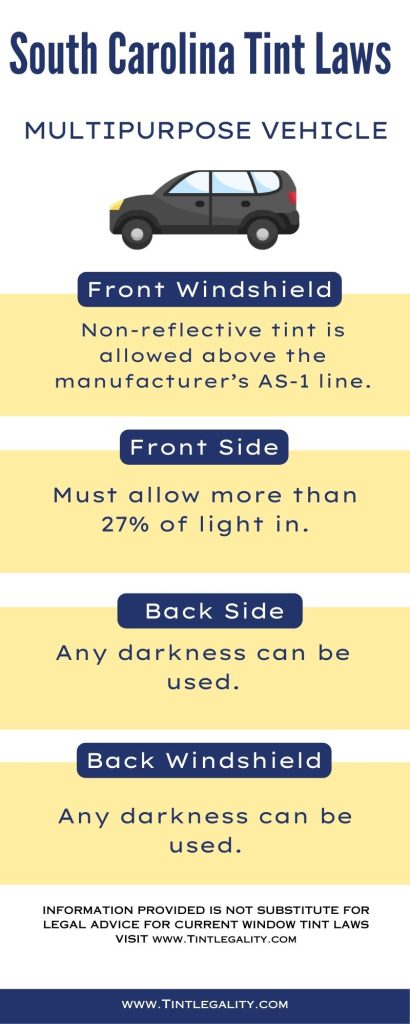South Carolina tint laws, first enacted in 1992, have undergone numerous modifications to cater to the evolving needs of the state’s residents.
Understanding these laws is crucial for every car owner, as they govern the acceptable degree of window tinting to ensure road safety and visual integrity.
Understanding Visible Light Transmission (VLT) in South Carolina
In South Carolina, the degree of window tinting is determined by the amount of Visible Light Transmission (VLT) allowed through your car windows.
This is measured in percentages and varies for different types of vehicles such as sedans, SUVs, and vans.
Tint Limit for Different Vehicle Parts
For all vehicle types, non-reflective tint is allowed above the manufacturer’s AS-1 line on the windshield. This provision safeguards the driver’s visibility while on the road, enhancing safety for all road users.
For front-side windows, the law stipulates that they must allow over 27% light inside. This regulation applies equally to both sedans and SUVs or vans, ensuring that drivers can adequately see their surroundings and other motorists.
For sedans, back-side windows should allow over 27% light. However, for SUVs and vans, the darkness can be applied to several unspecified inches from the top of the window. This degree of freedom on window tint darkness acknowledges the varied uses of these types of vehicles.
For the rear window, sedans must allow over 27% light. However, for SUVs and vans, there is no specified limit on the darkness of the tint. This divergence caters to the privacy needs of larger vehicle owners.


Additional Regulations on Window Tint in South Carolina
South Carolina law also has provisions for tint reflection, which serves to reflect incoming light, reducing glare and heat. For both sedans and SUVs or vans, the front and back side windows must be non-reflective. Although state law does not provide specifics, it implies that reflective tints that interfere with driver visibility are not permitted.
In certain cases, medical exemptions are allowed for special tints. For the details and specific terms of these exemptions, it is advisable to consult state law or speak with a local law enforcement officer.
While the state encourages creativity and individuality, South Carolina tint laws specify that tint colors in red, amber, or yellow are not permitted by law.
When the back window is tinted, dual side mirrors are required. This regulation enhances visibility, compensating for any visual limitations that the tinting on the back window might cause.
There are exceptions to the legal limits of window tints in South Carolina. For instance, film manufacturers need to certify the film they sell in the state, and there should be a sticker to identify legal tinting on the film and the glass of the tinted window.
Penalties for Non-Compliance with South Carolina Window Tint Laws
Penalties are imposed for non-compliance with the South Carolina window tint laws. The law is quite strict, and ignoring it could lead to serious consequences. Fines form a significant part of the penalties. Let’s take a closer look at the progression of fines for consecutive convictions:
- First Conviction: Misdemeanor with a minimum of a $200 fine.
- Second Conviction: The penalties become more stringent with a higher fine.
- Third Conviction: At this point, the fine increases further, showing the seriousness with which the state takes window tint law compliance.
In addition to fines, there are other penalties for non-compliance, which include but are not limited to jail time or community service. Ignoring the window tint laws is a misdemeanor that is not taken lightly.
In essence, South Carolina window tint laws strike a balance between allowing citizens the freedom to customize their vehicles and ensuring road safety.
As such, it is advisable to be familiar with and adhere to these laws to avoid penalties and to contribute to the safety and well-being of all road users.
Remember, ignorance of the law is not a valid excuse.
References: